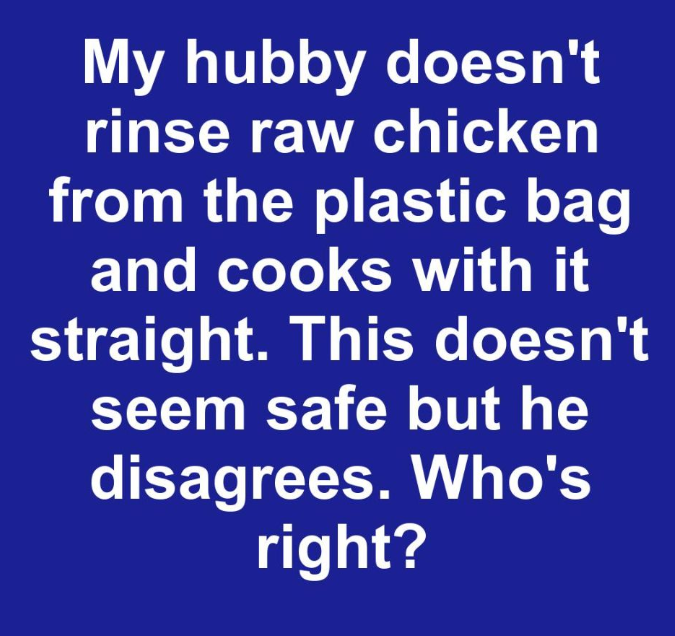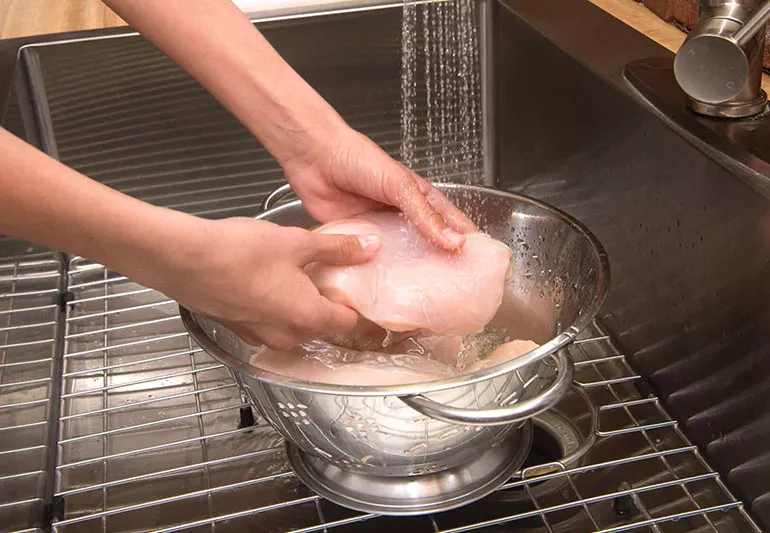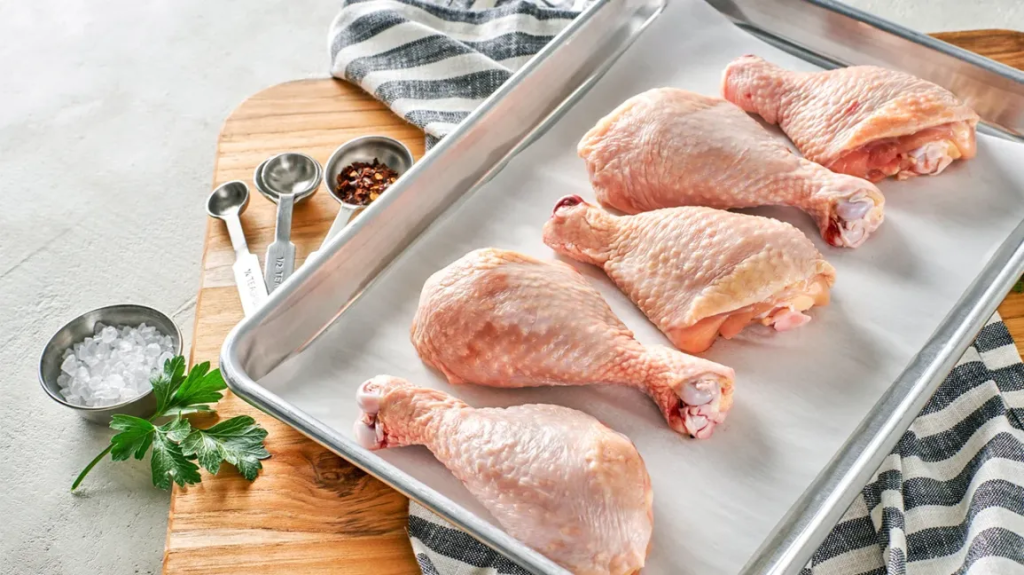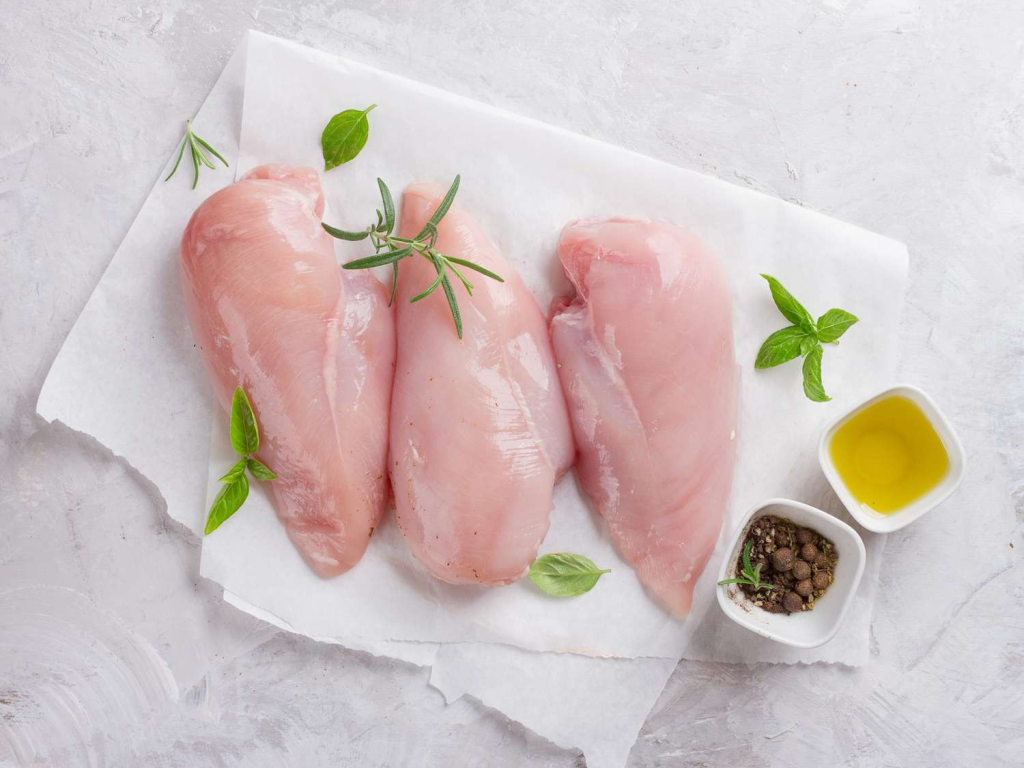The debate over whether to rinse raw chicken before cooking has been a long-standing kitchen controversy. Some people swear by washing their poultry, believing it removes bacteria and impurities, while others follow modern food safety guidelines that warn against it. But what does science say?
Let’s dive into the facts, bust the myths, and understand the best practices for handling raw chicken safely.

The Importance of Food Safety When Handling Raw Chicken
Raw chicken is a breeding ground for harmful bacteria such as Salmonella and Campylobacter—two of the most common causes of foodborne illnesses. If not handled properly, contaminated chicken can lead to severe stomach issues, fever, and even hospitalization.
To keep your kitchen safe, understanding how bacteria spread and how to minimize the risks is crucial. Proper handling, storage, and cooking techniques play a significant role in ensuring that your meals are not just delicious but also safe to eat.
Video: The raw truth: Don’t wash your chicken
The Science Behind Washing Raw Chicken
For decades, many home cooks have believed that rinsing raw chicken under running water helps remove germs, dirt, and slime. However, scientific studies suggest the opposite.
- Bacteria Are Not Easily Washed Away – Water alone cannot eliminate harmful bacteria on chicken. The only sure way to kill these pathogens is by cooking chicken to an internal temperature of 165°F (75°C).
- Water Splashes Spread Germs – Washing chicken in the sink increases the risk of cross-contamination. Bacteria-laden water can splash onto nearby surfaces, utensils, and even your hands, spreading germs across your kitchen.
- The USDA and CDC Advise Against Washing Chicken – The U.S. Department of Agriculture (USDA) and the Centers for Disease Control and Prevention (CDC) strongly discourage rinsing raw poultry because it poses more risks than benefits.
The Risks of Rinsing Raw Chicken
Many people don’t realize how far bacteria can travel when they rinse raw chicken. Here are some of the key dangers:
- Cross-Contamination: Water droplets carrying bacteria can land on kitchen counters, cutting boards, and other food items, increasing the chances of illness.
- Increased Risk of Foodborne Illness: Handling contaminated water or touching other foods after washing chicken can spread bacteria to fruits, vegetables, and cooked meals.
- False Sense of Cleanliness: Washing raw chicken may make it look cleaner, but it doesn’t remove harmful bacteria. In fact, it just spreads them around.
What Happens If You Don’t Rinse Chicken?

You might be wondering—if you don’t rinse chicken, won’t it still carry bacteria? The answer is yes, but it doesn’t matter as long as you cook it properly. The heat from cooking is the ultimate safeguard against bacteria.
- Cooking Kills Bacteria: Once the chicken reaches 165°F (75°C) internally, any harmful bacteria present will be destroyed.
- Drying the Chicken Instead: If excess juices or packaging residue bother you, patting the chicken dry with paper towels is a much safer option. Just remember to discard the towels immediately and wash your hands thoroughly.
Common Misconceptions About Washing Chicken
There are a lot of myths floating around about why people think washing chicken is necessary. Let’s clear up some of the biggest misconceptions.
- “Washing chicken removes bacteria.”
- No, it doesn’t. Rinsing does not kill bacteria—it only spreads them. Cooking is the only effective way to eliminate germs.
- “Rinsing chicken removes slime and blood.”
- While rinsing may wash away visible residue, it does not affect bacteria. A better approach is to dry the chicken with paper towels if necessary.
- “My family has always washed chicken, and no one has ever gotten sick.”
- Many unsafe food habits can go unnoticed until someone actually falls ill. The absence of sickness doesn’t mean the method is safe—it just means you’ve been lucky.
What the Experts Say: USDA and CDC Guidelines

Both the USDA and CDC have issued clear recommendations about handling raw chicken safely:
- Do Not Rinse Raw Chicken – Avoid washing poultry to prevent bacterial spread.
- Use Separate Cutting Boards – Keep raw chicken away from other foods, especially fresh produce.
- Cook Chicken to 165°F (75°C) – Always use a meat thermometer to ensure safe cooking temperatures.
- Clean and Sanitize Surfaces – Wash hands, countertops, and utensils thoroughly after handling raw poultry.
- Store Chicken Properly – Keep raw chicken refrigerated at 40°F (4°C) or below and use it within 1-2 days for maximum freshness.
Rinsing vs. Not Rinsing: Which Method is Safer?
If you’re still on the fence about whether or not to rinse raw chicken, let’s compare the risks and benefits side by side.
| Practice | Pros | Cons |
|---|---|---|
| Rinsing Chicken | Removes some visible residue | Spreads bacteria, increases contamination risk |
| Not Rinsing Chicken | Prevents bacteria from spreading, follows expert guidelines | May feel unnatural if you’re used to rinsing |
Clearly, not rinsing is the safer choice. It minimizes contamination risks and aligns with the best food safety practices.
How to Prepare Chicken Safely Without Rinsing

If you’re ready to ditch the habit of rinsing raw chicken, here’s how you can handle it safely:
- Remove the Chicken from Packaging Carefully – Avoid splashing raw juices on countertops or other food items.
- Pat Dry with Paper Towels – If the texture bothers you, gently dab the chicken dry and discard the towel immediately.
- Use a Dedicated Cutting Board – Keep raw poultry separate from fruits, vegetables, and other ingredients.
- Cook Chicken Thoroughly – Always check the internal temperature with a thermometer.
- Wash Your Hands and Kitchen Surfaces – Use soap and hot water to clean up after handling raw chicken.
The Final Verdict: Should You Wash Raw Chicken?
No, you should not rinse raw chicken before cooking. It doesn’t remove bacteria, but it does increase the risk of spreading harmful germs around your kitchen. Instead, focus on proper cooking techniques, thorough handwashing, and keeping surfaces clean to ensure food safety.
By following expert-backed food safety guidelines, you can confidently prepare chicken in a way that’s not just delicious—but also safe for you and your family.


